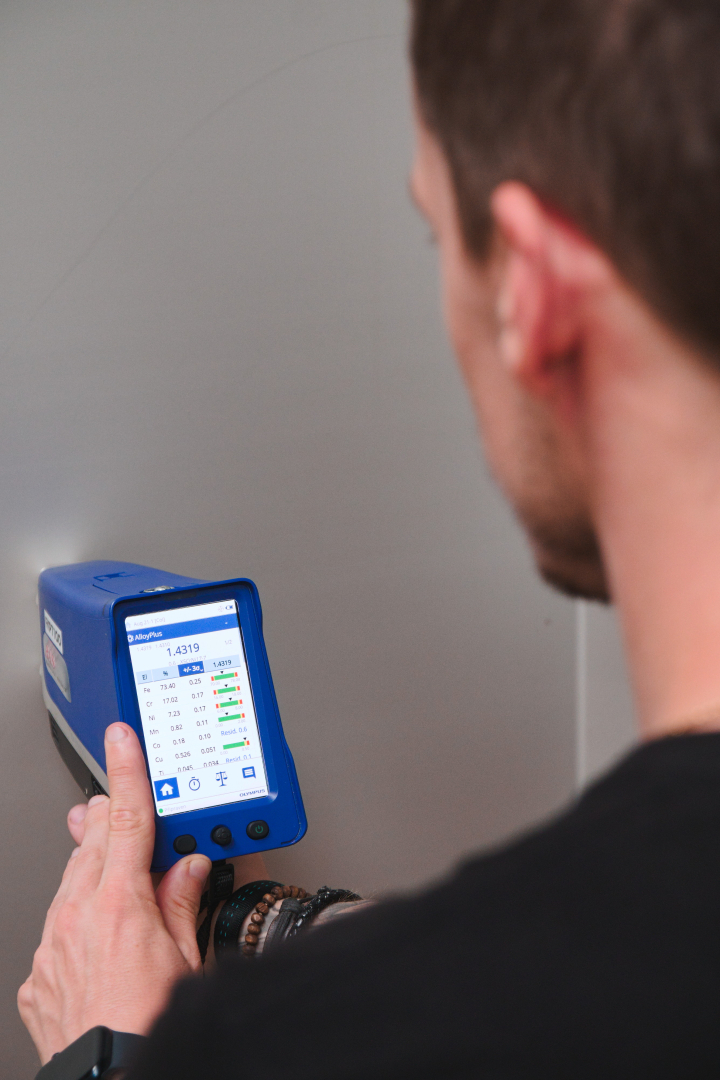Recycling of Stainless Steel – Limits and the Effect of Copper Content
6. 11. 2025
Recycling of Stainless Steel – Limits and the Effect of Copper Content
Stainless steel is one of the most important engineering materials today. It offers high mechanical strength, long service life, and—above all—exceptional corrosion resistance. A major advantage is its ability to be recycled repeatedly, contributing to sustainability and efficient resource management.
Although stainless steel can be recycled almost indefinitely, the process is not without challenges. One of the most critical limiting factors is the presence of copper (Cu).
Copper content in stainless steel
In standard stainless steels, copper is usually present only in trace amounts (typically less than 0.3%). However, in recycled scrap it can enter from various sources—most commonly from electronic waste or highly alloyed specialty steels.
Unlike carbon or sulfur, copper cannot be removed from molten steel by conventional metallurgical processes, which means it accumulates over time and can deteriorate material performance.
Effects of increased Cu content in stainless steel
Excessive copper content directly affects stainless-steel properties:
To ensure the quality of recycled stainless steel, it is essential to:
Therefore, systematic control of chemical composition is essential to ensure that recycled stainless steel meets all relevant standards and specifications.

.jpg)
Although stainless steel can be recycled almost indefinitely, the process is not without challenges. One of the most critical limiting factors is the presence of copper (Cu).
Copper content in stainless steel
In standard stainless steels, copper is usually present only in trace amounts (typically less than 0.3%). However, in recycled scrap it can enter from various sources—most commonly from electronic waste or highly alloyed specialty steels.
Unlike carbon or sulfur, copper cannot be removed from molten steel by conventional metallurgical processes, which means it accumulates over time and can deteriorate material performance.
Effects of increased Cu content in stainless steel
Excessive copper content directly affects stainless-steel properties:
- Structural weakening: Copper tends to segregate along grain boundaries, making the steel more brittle and more prone to cracking.
- Impact on surface treatment: Copper can adversely affect pickling and passivation—processes essential for forming a compact chromium oxide (Cr₂O₃) passive layer that provides corrosion resistance. Elevated Cu content can cause defects in this passive film, increasing susceptibility to localized corrosion.
To ensure the quality of recycled stainless steel, it is essential to:
- perform precise scrap sorting,
- analyze chemical composition during melting, and
- limit the use of materials with excessive Cu content to specific alloys where copper is desired or permitted, such as austenitic steel EN 1.4539, duplex steel EN 1.4501, and other special grades.
Therefore, systematic control of chemical composition is essential to ensure that recycled stainless steel meets all relevant standards and specifications.

.jpg)
Přečtěte si také
-
1. 12. 2025
Koroze oceli: Tichý likvidátor průmyslových projektů a jak ho zastavit
Moření a pasivace patří mezi klíčové procesy povrchové úpravy nerezové oceli. Zajišťují její dlouhodobou odolnost vůči korozi a zachování estetického vzhledu. -
29. 10. 2025
Jaký je rozdíl mezi mořením a pasivací nerezové oceli?
Moření a pasivace patří mezi klíčové procesy povrchové úpravy nerezové oceli. Zajišťují její dlouhodobou odolnost vůči korozi a zachování estetického vzhledu. -
11. 9. 2025
Pozvánka na Mezinárodní strojírenský veletrh v Brně 2025
Vážení zákazníci, vážení přátelé, srdečně vás zveme na Mezinárodní strojírenský veletrh v Brně. Najdete nás od 7. do 10. října v pavilonu A1 na stánku A1/39. -
5. 9. 2025
Recyklace nerezové oceli – limity a vliv obsahu mědi
Nerezová ocel je jedním z nejvýznamnějších průmyslových materiálů díky své pevnosti, odolnosti a recyklovatelnosti. Proces recyklace však naráží na určité limity – jedním z nich je obsah mědi, který... -
17. 7. 2025
Jsme součástí CZECH AEROSPACE Clusteru! ✈️
Společnost FK system - povrchové úpravy, s.r.o se v červnu 2025 stala členem CZECH AEROSPACE Clusteru, který sdružuje klíčové subjekty českého leteckého průmyslu. -
2. 7. 2025
Účast na Aerospace & Defence Meeting v Rzeszowě - letecký průmysl
Společnost FK system - povrchové úpravy, s.r.o se v květnu 2025 zúčastnila polského veletrhu se zaměřením na letecký a obraný průmysl. Účast přinesla nové kontakty a informace, včetně zavedení ISO...
FK system
Are you interested in our services?
Do not hesitate to contact us.
Secretariat
Menu
Services
Created by PS Works s. r. o.